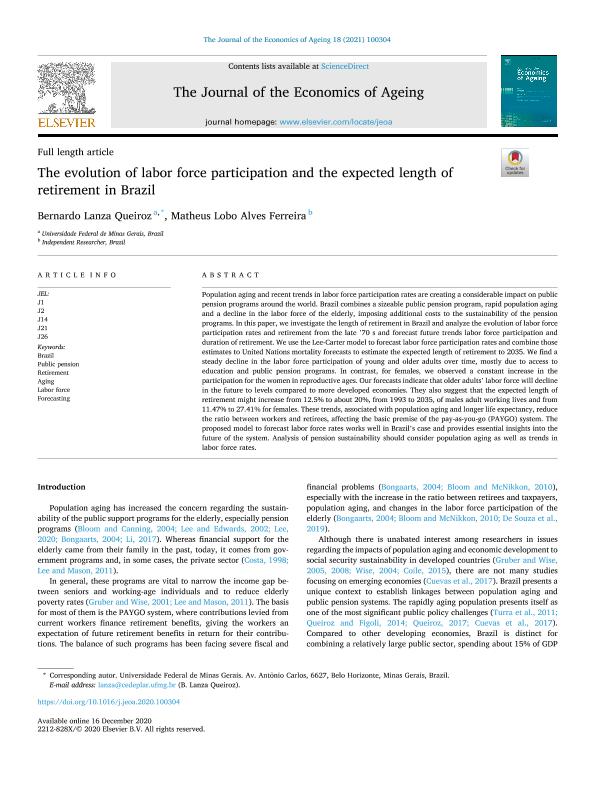The Evolution of labor force participation and the expected length of retirement in Brazil

Contenido multimedia no disponible por derechos de autor o por acceso restringido. Contacte con la institución para más información.
| Tag | 1 | 2 | Valor |
|---|---|---|---|
| LDR | 00000cab a2200000 4500 | ||
| 001 | MAP20210010323 | ||
| 003 | MAP | ||
| 005 | 20210405201752.0 | ||
| 008 | 210329e20210201esp|||p |0|||b|spa d | ||
| 040 | $aMAP$bspa$dMAP | ||
| 084 | $a6 | ||
| 100 | 1 | $0MAPA20210005251$aLanza Queiroz, Bernardo | |
| 245 | 1 | 4 | $aThe Evolution of labor force participation and the expected length of retirement in Brazil$cBernardo Lanza Queiroz, Matheus Lobo Alves Ferreira |
| 520 | $aPopulation aging and recent trends in labor force participation rates are creating a considerable impact on public pension programs around the world. Brazil combines a sizeable public pension program, rapid population aging and a decline in the labor force of the elderly, imposing additional costs to the sustainability of the pension programs. In this paper, we investigate the length of retirement in Brazil and analyze the evolution of labor force participation rates and retirement from the late '70 s and forecast future trends labor force participation and duration of retirement. We use the Lee-Carter model to forecast labor force participation rates and combine those estimates to United Nations mortality forecasts to estimate the expected length of retirement to 2035. We find a steady decline in the labor force participation of young and older adults over time, mostly due to access to education and public pension programs. In contrast, for females, we observed a constant increase in the participation for the women in reproductive ages. Our forecasts indicate that older adults' labor force will decline in the future to levels compared to more developed economies. They also suggest that the expected length of retirement might increase from 12.5% to about 20%, from 1993 to 2035, of males adult working lives and from 11.47% to 27.41% for females. These trends, associated with population aging and longer life expectancy, reduce the ratio between workers and retirees, affecting the basic premise of the pay-as-you-go (PAYGO) system. The proposed model to forecast labor force rates works well in Brazil's case and provides essential insights into the future of the system. Analysis of pension sustainability should consider population aging as well as trends in labor force rates. | ||
| 650 | 4 | $0MAPA20080554927$aJubilación | |
| 650 | 4 | $0MAPA20080552114$aPensiones | |
| 650 | 4 | $0MAPA20080577230$aPolítica laboral | |
| 650 | 4 | $0MAPA20200021438$aAgeingnomics. Economia senior | |
| 651 | 1 | $0MAPA20080637699$aBrasil | |
| 773 | 0 | $wMAP20210010194$tThe Journal of the economics of ageing $dOxford : Elsevier ScienceDirect, 2021-$g01/02/2021 Volumen 18 - 2021 , 11 p. |

